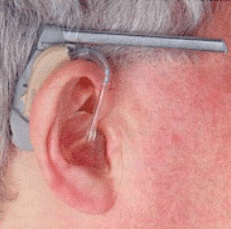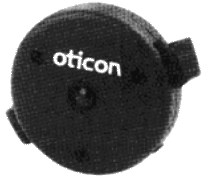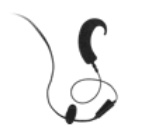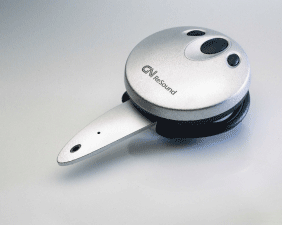Consumers report they want hearing aids to provide more benefit in noisy situations, have better sound quality and produce less feedback (Kochkin, 2002). Many of these problems occur due to limitations associated with hearing aid microphones. The microphone for ear-level hearing aids has a relatively small "effective area" within which it works maximally. The effective area is dictated by microphone size and location and can be thought of as the ideal area between the talker and listener. When the hearing aid user is listening to talkers located beyond this effective area, the strength of the signal of interest (the talker's voice) diminishes rapidly as the distance increases, making it difficult to hear. At the same time, interfering sounds (such as other talkers' voices or environmental sounds) that may be present within the effective area will be heard more dominantly than the signal of interest. As the signal of interest decreases and originates beyond the effective area, and unwanted sounds increase within the effective area, the signal-to-noise ratio (the loudness of the talkers voice versus the loudness of interfering noises) is reduced, making it difficult for the hearing aid wearer to hear clearly.
Hearing aid microphones can also cause difficulties while listening on the telephone. Feedback - the annoying whistling sound that hearing aids emit when a phone is located too close to the hearing aid - often occurs when people try to use the telephone while wearing hearing aids.
Fortunately, there is an inexpensive, useful, and often underused hearing aid component which overcomes these microphone problems. This option is the Telecoil (T-coil). T-coils allow different sound sources to be directly connected to the hearing aid, improving sound quality and allowing the hearing aid wearer to easily perceive the signal of interest in almost any environment, and regardless of background noise.
What is a telecoil and how does it work?
T-coils were first made available in hearing aids in the late 1940's (Lybarger, 1982). T-coils are comprised of a metal core (or rod) around which ultra-fine wire is coiled. T-coils are also called induction coils because when the coil is placed in an electromagnetic (EM) field, an alternating electrical current is induced in the wire (Ross, 2002b; Ross, 2004). The T-coil detects EM energy and transduces (or converts) it to electrical energy. T-coils can also be used to pick up magnetic signals, just as a microphone picks up an acoustic signal; the T-coil then sends the signal to the hearing aid circuit or processor for amplification.
T-coils may be passive, which is the conventional type of T-coil, or active. Passive T-coils are primarily a rod with a thin wire wrapped around it. Active t-coils are essentially passive T-coils with a pre-amplifier which may be useful to filter the electromagnetic interference generated by digital cell phones (Marshall, 2002).
T-coils can usually be built into behind-the-ear (BTE) and in-the-ear (ITE) hearing aids, and, can occasionally be built into in-the-canal (ITC) and completely-in-the-canal (CIC) hearing aids, provided there is sufficient room in the hearing aid shell to accommodate the telecoil. Telecoils can be found in analog, digitally programmable analog (DPA) and digital signal processing (DSP) hearing aids. T-coils are included in some cochlear implant processors.
T-coil switch options
The T-coil in a BTE hearing aid may be activated by a Microphone-Telephone-Off (M-T-O) switch or a Microphone-Mic & T-coil (M-MT) switch. The "M" setting allows the microphone to receive the signal. The "T" setting allows EM signals to be detected by the T-coil; the "MT" option allows simultaneous access to signals picked up by the T-coil and the microphone. These M-T type switches can be difficult for individuals with reduced dexterity to operate. In custom hearing aid products such as ITEs, ITCs, and CICs, and some BTEs a toggle switch or push button may be used to activate the t-coil.
Touchless T-coils
A newer means of activating the T-coil is the ''touchless'' t-coil option. This induction system automatically switches from the microphone to the t-coil when it "senses" a source of EM, and switches back to the microphone when the EM field is no longer apparent (Marshall, 2002). This type of system makes T-coil activation easier for the hearing aid user, particularly for those with limited or reduced dexterity (Palmer, 2001).
Electro magnetic (EM) energy
A hearing aid user potentially has access to several sources of EM energy, the most common source being the opportune electromagnetic field generated by hearing-aid compatible telephones (Ross, 2002b). Traditional corded "land-line" and some cordless phones and analog wireless phones generate electromagnetic fields that can be detected by the T-coil in a hearing aid.
Other sources of EM energy are Induction Loop (IL) assistive listening devices. These systems, which consist of a microphone and amplifier to which a "loop" is connected, generate an EM field. Room loop systems are available for use in auditoriums and other large settings. Portable IL systems that use a lasso-type loop of different sizes can be placed around a conference table or chair. Sheeting of various dimensions which emits EM signals can be placed under a rug or carpet.
When these types of IL systems are used, the hearing aid's T-coil will allow the listener to pick up the signal present at the IL system's microphone. In this case, no additional receiver is necessary. If the individual is using two hearing aids, both aids can be placed in the telecoil mode to allow binaural hearing of the signal present at the IL system's microphone. Speech understanding is typically better when both ears are engaged. Another option while wearing two hearing aids is to have one hearing aid can be set to the telecoil while the other remains in the microphone mode. This configuration allows the user to hear the signal sent through the IL system via the hearing aid set on "T" while nearby sounds, such as a companion's voice, are heard via the second hearing aid, set on "M".
Induction can also be used when a hardwired, frequency modulation (FM), or infra-red (IR) system is being used. In these cases, the hearing aid wearer can plug a neckloop or silhouette into the system's receiver. The neckloop is a small lasso that drapes around the neck and can be worn under a jacket or sweater. As with the larger room IL systems, the hearing aid wearer can choose to place only one or both hearing aids in telecoil mode when using the neckloop. The silhouette is flat and shaped like a BTE hearing aid. It is worn behind the ear, next to the skull. This device can be used with BTE or ITE hearing aids and is available in monaural (one ear only) and binaural (using a "y-cord" with two silhouette pieces) versions. Both the neckloop and the silhouette emit a magnetic signal which is detected by the hearing aid's t-coil. If the individual is wearing a hearing aid in each ear, the neckloop and a silhouette with a y-cord and two earpieces allow binaural hearing via the t-coil.
Another source of electromagnetic energy that can be used with a BTE or ITE hearing aid's T-coil is the Link-It Array Microphone. According to the manufacturer (Etymotic Inc) this array microphone provides more directional benefit than is provided by a directional microphone built into a hearing aid.

Link-It Array Microphone manufactured by and available from Etymotic Research (https://www.etymotic.com/pdf/linkit-brochure.pdf) and other distributors.
Getting the most from a hearing aid T-coil
Hearing would be much easier if conversations occurred in face-to-face quiet environments, with excellent lighting and no other background noises or distractions....but that probably won't happen. Therefore, it's a good idea to be prepared for your listening needs across all situations in which hearing is desirable.
If you find you need improved telephone listening, or want to hear speech coming from a distance (such as at a worship service) or hear speech occurring in a noisy setting (such as a social gathering), then a T-coil would benefit you. Additionally there are ways to maximize the benefit T-coils provide.
Proper T-coil orientation
T-coil orientation in the hearing aid affects the strength of the magnetic signal detected by the T-coil. For example, if the T-coil will be used with the telephone, a horizontal induction coil orientation is best. If the T-coil will be used with a neck loop or room loop, a vertical orientation is called for (Ross, 2002a). Because the physical mass of the t-coil and its orientation are dictated by the amount of room available in the hearing aid, you may need to consider a larger style hearing aid. The often-perceived cosmetic advantage of tiny hearing aids can be generally overcome by the functional benefits of t-coil use.
Programmable T-coils
Some hearing aid models include a T-coil that cannot be manipulated in terms of strength or loudness. However, some hearing aid models include a programmable T-coil that can be adjusted to provide the wearer with a maximized signal. Programmable T-coils are recommended.
Verified T-coil performance
When hearing aids are initially fit, the audiologist should use real-ear measures and EM signals to ensure that the T-coil programming is appropriate. Specifically, the audiologist can present a telephone's dial tone while using a real-ear measurement system to evaluate and adjust T-coil effectiveness. By holding the phone right next to the hearing aid, with a dial tone or "time and temperature" recording playing, the position which allows the greatest signal strength can be determined. It is important to understand that different phones vary in the quality and strength of the EM signals they emit. The position in which the T-coil is maximized for one phone may be different for another phone.
If you use the T-coil to pick up EM signals provided by an assistive listening system, the audiologist can also use real-ear measures to determine if a neckloop or silhouette provides the best quality signal (Aarts, 2003).
Instruction in T-coil use
Another way to maximize the benefit of your T-coil is to receive training on how to use it. Surveys have shown that adult hearing aid users believe they have received inadequate training on how to use their T-coils (Stika, Ross, and Cuevas, 2002). One study showed less than 50 percent of T-coil users reported receiving T-coil information from their audiologists (Stika, Ross, and Cuevas, 2002). A survey of hearing aid dispensing practices that subscribe to The Hearing Review demonstrated that 44% of responding audiologists routinely include T-coils in the hearing aids they fit (Strom, 2003).
When using a T-coil that is activated with a switch or programming button, or, if using a T-coil with multiple signal sources, training is especially important. In addition to training provided by your audiologist, information about telecoil use is available from the open-captioned videotape and brochures "The Telecoil: Plunging Into Sound," available from Self Help for Hard of Hearing People. These products can be ordered from https://www.hearingloss.org/cgi-bin/plugins/Merchants/shhh/store/merchant.cgi?product=cat07&cart_id=3185399.22756.
The Americans with Disabilities Act (ADA)
Another way to get the most value possible from your telecoil is to find out about the assistive devices available at places with public access in your community. Because of the Americans with Disabilities Act (ADA), assistive devices must be available at movie theaters and other entertainment venues, museums and businesses and government offices for use by individuals with hearing loss.
More information about the ADA is available from the following governmental web sites:
ADA Homepage
https://www.usdoj.gov/crt/ada/adahom1.htm
ADA Technical Assistance CD-ROM
https://www.usdoj.gov/crt/ada/adatacd1.htm
Enhance T-coils performance with assistive devices
If you already have hearing aids with T-coils, but the signal is too weak, a variety of devices are available to enhance the strength of the T-coil and the signal it receives.
Strap-on amplifiers
In the case of corded and cordless telephones and analog cellular telephones, using an inductive amplifier can increase the magnetic signal strength. These devices, which are usually powered by a small hearing aid battery, can be strapped onto any telephone handset. In some models, the amount of amplification provided to the EM signal can be adjusted with a volume control.

Oticon TA80 Induction Amplifier available from Hearing Resources (https://earlink.com/HA_oticon_ta80_induction_adapter.htm) and other distributors.
Amplifiers for digital cell phones
Digital cell phones, rather than being compatible with hearing aid t-coils, are often a source of interference. The interference generated by digital cell phones is caused by the electromagnetic field around the phone's antenna. This antenna is used to send and detect the radio waves (radio frequency emissions) used by the phone to transmit the signal over a wireless network. Interference may also be caused by the electronics housed in the digital cell phone. Interference is often worse when newer digital hearing aids are used (Kozma-Spytek, 2004). Fortunately devices are available for hearing aid users to improve a digital cell phone's EM signal.
Hearing Aid Telephone Interconnect System (HATIS) products come in a variety of neckloop and silhouette models and are compatible with almost all cell phones. Each has a standard 2.5 mm jack, a hands-free microphone, and a volume control. Devices may be for monaural or binaural use.

LITE HATIS BTE headset is for those with only mild hearing losses and is available from HATIS (https://www.hatis.com/lite.shtml) and other distributors.

MACH I HATIS BTE monaural headset for use with cellular phones is available from HATIS (https://www.hatis.com/freedom.shtml) and other distributors.
Bluetooth technology
The newest device used to improve cell phone compatibility with hearing aid T-coils is Bluetooth technology, wireless two-way radio transmission that allows one device to communicate with another over a small area. For hearing aid users who want to use a cell phone, Bluetooth technology has allowed the development of ear-level devices that can send and transmit the phone's signal to the hearing aid's T-coil. The cell phone must have a Bluetooth chip used for sending and receiving digital information. Particular hearing aids are compatible with Bluetooth headsets that sit on the ear and transmit the cell phone's signal directly to the hearing aid through the t-coil. The cell phone can be located as far as 25 feet from the headset. This device can be purchased in Europe but is not yet available in the U.S.A. (as of 7-1-2004).

BT100-TC headset with Bluetooth technology manufactured by GN ReSound.
Summary: Advantages and disadvantages of T-coils
T-coils have several advantages. T-coils built into hearing aids are relatively inexpensive and are, in fact, standard on most BTE models. Some T-coils can be programmed which maximizes T-coil performance for a particular hearing aid user. When T-coils are used with assistive devices the negative effects of distance, noise and reverberation are eliminated. When T-coils are used with phones, feedback is eliminated and loudness may be increased.
In terms of disadvantages, T-coils are susceptible to electromagnetic interference. Fluorescent lights, some computer monitors, motors, transformers, alarm systems, and digital cell phones, all radiate magnetic energy which may cause a humming sound (Compton, 1994). This hum may be reduced or eliminated if the hearing aid wearer moves their head slightly, repositions the neckloop or telephone, or moves away from stationary sources of EM energy (Mulvany, 2004).
While induction systems are not as common in the USA as they are in Europe, efforts are underway to increase T-coil use in the USA. The "Let's Loop America" initiative is an ongoing public awareness campaign designed to bring the benefits of T-coil use to more hearing aid users by offering clear, high quality sound to hearing aid users across communities (Myers, 2002). Currently two cities in Michigan, Holland and nearby Zeeland, have had IL systems installed in major churches, public facilities, and private homes. More information about "Let's Loop America" is available at www.Hearingloop.org.
Audiologists are encouraging patients to purchase hearing aids with T-coils. Due to the very low relative cost of the T-coil, the vastly improved sound quality and the ease and utility with which T-coils operate all hearing aid users should be given the opportunity to experience the amplification benefit provided by a T-coil.
References
Aarts, N. L. (2003, January 13). The t-coil: A way to maximize hearing aid usefulness. Advance for Audiology Online Editions. Retrieved January 30, 2003 from https://www.advanceforaud.com/
Compton, C.L. (1994, April). Providing effective telecoil performance with in-the-ear hearing instruments. The Hearing Journal, 47 (4), 23-26, 28-29, 32-33.
Kochkin, S. (2002, November). Marke Track VI: Consumers rate improvements sought in hearing instruments. The Hearing Review, 9 (11), 18-20, 22.
Kozma-Spytek, L. (2004). Digital cell phones and hearing aids FAQ. Retrieved May 24 2005 from https://www.hearingloss.org/html/qa_for_audiology_online_digita.HTM
Lybarger, S. (1982). Telephone coupling. In G.A. Studebaker, F.H. Bass (eds). The Vanderbilt hearing aid report. Upper Darby, PA: Monographs in Contemporary Audiology, 91-93.
Marshall, B. (2002, September). Advances in technology offer promise of an expanding role for telecoils. The Hearing Journal, 55 (9), 40-41.
Mulvany, D. (2004, January 19). Maximizing our ability to hear on the telephone. Healthy Hearing. Retrieved May 24 2004 from https://www.healthyhearing.com/healthyhearing/newroot/articles/arc_disp.asp?catid=1054&id=229
Myers, D.G. (2002, Sept). The coming audiocoil revolution. The Hearing Review, 28-31.
Palmer, C.V. (2001, September). Ring, ring! Is anybody there? Telephone solutions for hearing aid users. The Hearing Journal, 54 (9), 10, 12, 14, 18.
Ross, M. (2002a, January/February). Telecoils and telephones: The most commonly misunderstood "assistive listening device". Hearing Loss, 16-19.
Ross, M. (2002b, September). Telecoils: The powerful assistive listening device. The Hearing Review, 9 (9), 22-26, 57.
Ross, M. (2004). Telecoils deserve wider acceptance as assistive listening devices. ASHA Leader, 9 (10), 1, 30.
Stika, C.J., Ross, M., & Cuevas, C. (2002, May/June). Hearing aid services and satisfaction: The consumer viewpoint. Hearing Loss, 25-31.
Strom, K. (2003, June). The HR 2003 dispenser survey. Hearing Review, 10 (9), 22, 24, 26, 30-34, 37, 38.

